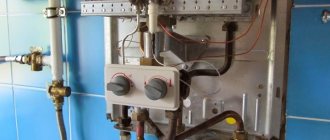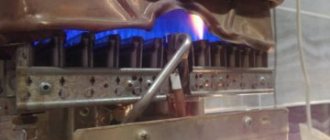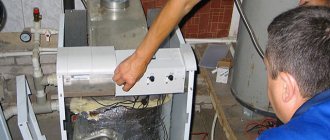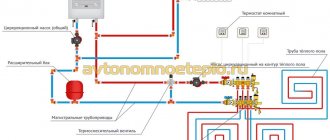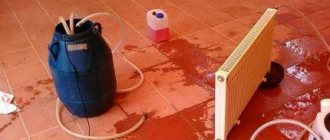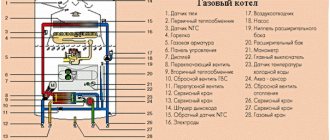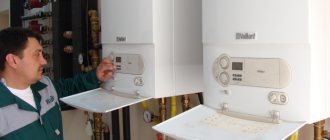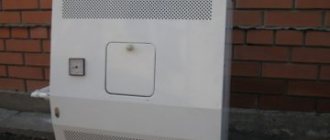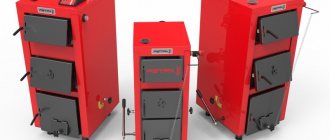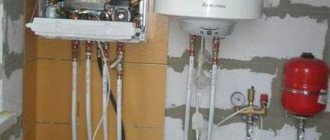Modern gas boilers are reliable mechanisms. But technology does not last forever, so equipment requires regular maintenance. The procedure includes checking the functionality of all parts and systems, and most importantly, cleaning them.
The procedure is not particularly complicated. Therefore, if there is no desire or opportunity to turn to professionals, it is quite possible to cope with it on your own. It is only important to understand the structure of the boiler and follow the technology for cleaning all parts.
When cleaning is necessary
A gas boiler is a complex device, and disassembling it without a good reason is too expensive. To avoid taking unnecessary actions that could cost you a pretty penny, check out a number of signs that indicate a clogged heating element:
- The boiler does not produce the required amount of heat, while consuming a large amount of fuel.
- During operation of the device, extraneous noise appears, the presence of which was not observed before.
- The water pressure from the tap decreases significantly.
- The heating process of the batteries is slower than usual.
Gas consumption has increased
One of the key reasons why gas consumption increases significantly compared to the norm is the clogging of the heat exchanger with scale. The boiler requires more fuel to heat the exchanger to the required level. After cleaning the part, the consumption returns to the basic values.
Burner always on
A clogged heat exchanger means that the water takes a long time to heat up, and the turbine constantly pumps in new liquid.
Because of this, the burner is constantly working, trying to bring the water temperature to the required value.
Descaling solves the problem, allowing the boiler to operate normally, without interruptions.
Rumble and interruptions in the operation of the circulation pump
A clogged system makes it difficult for fluid to circulate, causing the pump to overload during operation. Because of this, the following appear:
- extraneous noise;
- interruptions in the operation of the device;
- engine overheating.
Reduced pressure in the DHW circuit
A decrease in pressure in the DHW circuit is possible due to:
- incorrect operation of the heat exchanger;
- leaks in the pipeline system;
- The hot water supply circuit is depressurized.
Note! The above symptoms can occur not only due to the boiler being clogged with scale. This should be taken into account when diagnosing a fault.
Routine inspection of gas equipment in the apartment
During the term of the contract, gas workers are required to carry out scheduled inspections of equipment and all connecting systems.
The frequency of such inspections may be established by agreement. In this case, the consumer is given a corresponding act. In addition to such visits, they are obliged to respond as soon as possible and go to the owner’s address if he reports a detected malfunction. On-site inspection and work to eliminate it is carried out. If gas appliances are used correctly, one check for the entire term of the agreement is sufficient. If the equipment’s service life has expired, gas workers recommend replacing it or carrying out diagnostics in a specialized organization. If the period is extended in conclusion, its service becomes annual.
Organizations servicing gas equipment prepare documentation for each room indicating all the devices located there, indicating the date of installation and service life.
About the dangers of scale
Scale that forms in key components of a gas boiler leads to the following negative consequences:
- The thermal conductivity of the part deteriorates, since scale has high porosity.
- Scale deposits lead to uneven heating of the system, which can lead to ruptures at the welding points of various elements of the device.
- The information supplied to the liquid temperature control sensors no longer corresponds to reality. This will reduce the performance of the equipment.
- Partial or complete blockage of the working ducts will, in the long term, lead to breakdown of expensive equipment.
See also
How to clean a thermos, methods and TOP 18 remedies at home
Turbine maintenance
Gas boiler turbine
The exhaust fan ensures proper removal of carbon dioxide, soot and smoke after combustion of the gas mixture. After dismantling the fan, it is worth checking the chimney pipe leading to the street for clogging. The fan must be cleaned of dust and the shafts lubricated. The condensate collector leading to the turbine must be sealed.
What needs to be cleaned
If the heating system is clogged, the following elements must be checked:
- burners and jets;
- heat exchanger;
- igniter;
- gas filter;
- firebox;
- chimney channels.
If they do not work correctly, it is necessary to clear the blockages.
Igniter
A yellowish, uneven flame from the pilot light signals the boiler owner about the need to clean it. To do this you will need:
- close the gas valve, stopping the fuel supply to the boiler;
- remove the igniter;
- blow out and clean the part from debris;
- install in place.
Burners and jets
If the gas burner of the boiler operates unstable, cleaning becomes necessary. Algorithm of actions:
- shut off the gas supply to the boiler;
- remove the burner;
- We mark the position of the injectors with a marker, and then dismantle them;
- we blow through the inlet and outlet openings of the burner using a pump;
- carefully clean with a brush;
- we install the nozzles back, focusing on the marks left by the marker;
- return the burner to its original position.
Chimney ducts
Interruptions in the operation of the boiler affect not only the heating circuit and the pump. The chimney begins to become more clogged with soot, which increases the risk during its operation. Reduced draft can result in carbon monoxide entering the room, which negatively affects human health. Clean the chimney using a regular brush.
Be careful when cleaning the outlet. It is usually located at a high altitude, which creates an additional risk to human life. Don't forget about safety rules. If possible, hire professionals who have all the necessary skills and tools.
Heat exchanger
Cleaning the heat exchanger on your own comes down to mechanical action on the part, due to which excess dirt and scale are removed. You will need:
- brush;
- metal brush;
- wrench.
We turn off the gas supply to the boiler, remove the protective cover of the boiler and deactivate the temperature sensors. Afterwards the heat exchanger is dismantled and cleaned. Do it carefully so as not to damage the part. It is not recommended to use tools with sharp edges that can damage the heat exchanger.
Gas filter
The gas supplied to the boiler through public pipes carries many harmful impurities and debris. The task of the gas filter is to separate them at the inlet, preventing them from entering the heating system. A clean filter provides:
- stable operation of the device;
- slows down the appearance of plaque on system parts and the internal walls of gas pipes.
Firebox
The firebox, like the chimney, can be cleaned using regular brushes. Excess soot is removed, which contributes to comfortable and stable operation of the gas boiler.
Note! If you are not confident in your own abilities, do not take risks by cleaning yourself and seek help from specialists.
How to clean a floor-standing gas boiler: step-by-step instructions
Before any action, you should turn off the gas supply valve (or make sure that it is turned off). Let's look at the process using the example of the widespread Danko non-volatile boiler. The design of all floor-standing gas boilers is not fundamentally different, so you can easily adapt the instructions to any model and identify all the key components.
| Photo (click to enlarge) | Process description |
| Disassembly . Open and remove the door, then disconnect all the components shown in the photo: (1) gas supply; (2) burner block mounting; (3) terminal contacts; (4) thermal bulb. Now you can remove the burner and automation unit. We also unscrew and remove the boiler cover (2 screws in front and 2 in back) | |
| From above, to get to the heat exchanger, you need to remove the thermal insulation layer, the chimney mounting cover and the metal plate. All components are usually arranged in series and secured with bolts. | |
| Cleaning the heat exchanger. The heat exchanger channels (they can be round, as in the photo, or rectangular) contain swirlers. We take out each one in turn and clean it of soot and dirt. It can be done:
To clean the fire tube channels of the heat exchanger, you need to use a special metal brush, lowering it to the very depths. After mechanical cleaning, it is good to vacuum up any loose debris and proceed to cleaning the burner block. |
| Cleaning the main burner . The main burners are practically not dirty; use a cloth for cleaning, or metal brushes for more severe contamination. Clean the external and internal surfaces of the burners, make sure that all openings are in proper shape and are not clogged. |
| Cleaning the igniter and automation . It is recommended to entrust the cleaning of these elements to specialists; otherwise, carefully study the exact location of all elements relative to the main burner, photograph the components from different sides. Based on the photo, remove and clean: (1) piezo ignition electrode; (2) a pilot burner, also known as an igniter; (3) thermocouple. This must be done carefully, using zero-grit sandpaper or a soft brush, without leaving scratches. Also an excellent remedy is cotton wool and alcohol. | |
| When cleaning the igniter, thoroughly blow out the nozzle; if it is heavily soiled, punch a hole with a wire or needle, and under no circumstances allow damage or deformation. | |
| Assembly . We install all the elements in their places; in most models, the piezoelectric ignition electrode must have a small amount of free play (play) so that it does not break when heated. |
Often, during long-term operation of a gas boiler, it is necessary to clean the chimney from soot, which is important in order to avoid weak or reverse draft. This is done with long brushes or homemade devices.
How to choose a water softener for a gas boiler and extend the life of the heat exchanger
Disassembly sequence
Disassembling the boiler to remove a clogged part consists of the following sequence of actions:
- First of all, the boiler is turned off so that its parts cool down. This usually takes 30-40 minutes;
- Next, close the taps responsible for the supply of gas and water;
- remove the front panel;
- drain the water remaining inside the boiler;
- dismantle the heat exchanger;
- we clean it.
See also
How to clean a bicycle chain with your own hands and the best cleaners
Basic cleaning methods
The heat exchanger is cleaned in the following ways:
- mechanical;
- using chemical reagents;
- hydrodynamic;
- electric discharge.
Mechanical
The mechanical method involves manual cleaning using various auxiliary tools. This is the simplest and cheapest method that does not require the owners to spend money and time. However, its effectiveness leaves much to be desired. Mechanical cleaning does not provide a 100% guarantee that the problem will be corrected.
What you will need
To mechanically clean the heat exchanger you will need to prepare:
- brush;
- brush;
- vacuum cleaner.
Refrain from using tools that have sharp edges. They can damage heating system components.
How to clean
We remove the part needed for cleaning and carefully treat its surface with a brush. To clean the internal surfaces of the part, use a brush or vacuum cleaner.
Using chemically active substances
Chemical cleaning is much more effective than mechanical cleaning, due to the removal of blockages in hard-to-reach places that cannot be reached with a regular brush. Advantages of the method:
- efficiency;
- speed.
Minuses:
- reagents cost money;
- chemicals are harmful to the human body and must be used extremely carefully;
- requires specific equipment, which you will have to purchase in a store or do it yourself.
What is a booster and how to mount it yourself
A booster is a special device that circulates chemicals inside the heat exchanger. To make a booster on your own, you need to prepare:
- pump;
- hoses with a diameter of 1\2 or 3\4 inches;
- container for chemistry.
We connect one end of the hose to the pump, and screw the other onto the heat exchanger. We screw the second hose to the outlet of the heat exchanger, and lower its free end into a container with chemicals. The pump must also be located in a chemical tank.
Depending on the type of pump, the chemical tank may require some modification.
How to clean a heat exchanger using a booster
When using a booster with heating element you will need:
- disconnect the boiler from the heat exchanger;
- attach hoses to it;
- fill the container with chemicals;
- turn on the booster.
Note! When using a booster without heating element, you will have to turn on the boiler at 1/3 power so that the liquid warms up to 45 o. This must be done very carefully, otherwise an accident may occur. If you are not sure of the final result, seek help from specialists.
Heat exchanger cleaning products
To remove scale accumulated on the walls of the heat exchanger, the following is suitable:
- special acid;
- Detex.
Types of acids for cleansing
The following acids deal with scale:
- lemon;
- sulfuric;
- sorrel;
- salt;
- sulfamic.
Sulfuric
Used when there is a large amount of scale that has formed a thick layer on the walls of the heat exchanger. It must be used with caution as it is extremely toxic.
Lemon
Citric acid, heated to 60 o, is considered an effective remedy for combating various deposits that interfere with the full operation of a gas boiler. Suitable for cleaning parts made from:
- stainless steel;
- copper;
- brass
The minimum concentration of the solution is 0.5%, and the maximum is 1.5%.
Solyanaya
Hydrochloric acid solution is used when processing products from:
- stainless steel;
- copper
Special additives are added to the solution to prevent the destruction of the metal shell of the product. It is recommended to use it as a last resort if there are no other options. It is extremely toxic, and when working with it, strict safety regulations must be followed.
See also
How to wash resin from your hands, TOP 8 products and prohibited methods
Sulfamine
Qualitatively removes scale deposits, which include metal oxides. A good choice for cleaning boiler parts at home. Safe for most materials used in boiler assembly.
Sorrel
Pros of using oxalic acid:
- cleans scale and traces of rust;
- does not damage painted parts.
If precautions are taken, it can be used for cleaning at home.
Detex
Special liquid designed to remove traces:
- oxides;
- scale;
- salts
Interacts well with products made of steel, cast iron or copper, increasing their service life.
Hydrodynamic flushing
Allows you not to disassemble the heat exchanger, cleaning its walls due to high water pressure. If the scale is too strong, abrasives are added to the liquid. It is carried out using special equipment. It is not recommended to carry out such washing yourself, without supervision from specialists.
Electric discharge
The essence of the method is that the cleaning liquid is exposed to electrical discharges. They penetrate the structure of sediments, breaking them into small pieces. In addition, the discharges create high-speed streams that carry away crushed scale particles, thus clearing the passages of blockages.
It is very easy to clean scale in this way, but it requires special equipment and the help of specialists.
We pay attention to the firebox and chimney duct
Natural gas differs from solid and liquid fuels in that it is a pure fuel product. However, not so much that there are no combustion products, which during the operation of the boiler accumulate on the inner surface of the combustion part and inside the chimney duct.
There are many devices that are used to clean chimney ducts from soot: these are brushes, brushes of various configurations and sizes. You can buy them in stores or take old brushes intended for household needs.
Features of cleaning boilers of different brands
Depending on the manufacturer of the water heating equipment, cleaning may have a number of nuances that must be taken into account. Let's look at the most common brands.
Baxi
The main feature of Baksi boilers is the presence of a secondary plate heat exchanger. This is worth considering when choosing a cleaning product.
Navien
A South Korean manufacturer that produces water heating products adapted to Russian conditions. When washing it, no problems arise, since the system has increased stability and reliability.
Ariston
Ariston equipment is equipped with additional water purification filters, which is why the water entering the system is cleaner than usual. This allows you to go without cleaning for a long time and use gentle options when choosing chemicals.
Vaillant
The operating temperature recommended by the manufacturer is within 40-50 o. If you follow this, scale will accumulate in the heat exchanger more slowly.
Beretta
A high-quality manufacturer that adapts its products to Russian realities. Does not have any special features during cleaning. It is carried out by analogy with most similar products.
Arderia
Another brand from South Korea, equipped with two heat exchangers. If the product does not operate correctly, it is advisable to clean both parts.
Do-it-yourself heating flushing
For self-flushing radiators, mechanical cleaning technology is most applicable. In this case, you will not have to use any special equipment or specific chemicals. Before you wash the heat exchanger of a gas boiler with your own hands, you should prepare the necessary materials:
- rags or old thick clothes. With their help, it will be possible to protect the bathtub from damage during the process of flushing the radiators in it;
- fum tape or plumbing linen with a tube of sealing paste;
- a pipe that allows you to connect a hose to threaded connections.
The equipment you will need is the following:
- two hoses;
- a set of keys;
- brush;
- steel wire brush;
- buckets, basin and rags.
The actual cleaning of the heat exchanger and lines consists of several stages.
- A hose of the appropriate diameter is connected to the drain pipe of the heating system. The other end of the hose is discharged into the sewer.
- A second hose is connected to the highest point of the system. As a rule, such a point is either a branch to the expansion tank or a safety group. The tank or safety group is unscrewed and a pipe is screwed into its place, onto which a hose is put. The second end of the hose is connected to the water supply.
- When everything is ready, water is supplied to the system. This makes it possible to get rid of scale and contaminants deposited in the system lines.
- Start draining the coolant. To do this, remove the hose through which tap water was supplied. The connection point to the system is not blocked. Under the influence of gravity, water begins to drain through the drain pipe at the lowest point of the line.
To completely drain the coolant, it is necessary to ensure that the outlet end of the hose is below the level of the heating system lines. In a private house, it will be possible to achieve such a configuration if you drain the water into buckets installed in the underground.
Radiators are removed from the dehydrated system
Care must be taken when doing this. It is likely that the threaded connections on them are coked and you will have to make some efforts, trying not to damage the threads. The removed radiators are transferred to a bathtub, previously covered with rags or thick fabric. Here they are washed with running water, treated with a brush and a steel wire brush.
After flushing the radiator, it is carefully inspected again for any remaining contaminants. Radiators are installed in place
Here they are washed with running water, treated with a brush and a steel wire brush. After flushing the radiator, it is carefully inspected again for any remaining contaminants. The radiators are installed in place.
The lines are filled with fresh water through the drain pipe. At the same time, monitor the formation of air pockets in the pipes and radiators. You can get rid of air bubbles by slightly opening the Mayevsky valves on the radiators. As soon as the air stops hissing and water begins to ooze from the tap, close it. As the lines fill, it is advisable to repeat this procedure several times. After the actual washing of the gas boiler heat exchanger is completed with your own hands, the heating system is put into operation. As the coolant begins to circulate, air pockets in the radiators may re-form. To eliminate them, the Mayevsky cranes are manipulated again. Some of the air will be removed independently through the air vent. As the pipelines and radiators are freed from air, the coolant pressure will drop. To level it, it is necessary to additionally pump water from the water supply. In addition, you should check the pressure in the expansion tank.
